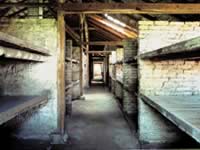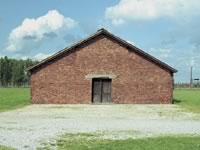 |
       |  |
|
|
|||||||||||||||
 Auschwitz Aufnahmen Anlässlich des 70. Jahrestages der Befreiung ca. 15 Ausgaben der in 2003 publizierten Arbeit sind in Russisch, Polnisch und Französisch verfügbar. Signatur, Box mit Stempel u. Signatur, 175,-€ s. a. The Photobook Vol. II, Martin Parr/Gerry Badger, Seite 244/245 Material Auschwitz-Birkenau Photoband Auszug (PDF, ~450Kb)  Deutsch Deutsch English English Français Français Polskie Polskie Русский перевод Русский перевод»Prolog« Gerhard Schoenberner  Deutsch Deutsch English English Français Français Polskie Polskie Русский перевод Русский перевод»Epilog« Stefan Skowron  Deutsch Deutsch English English Français Français Polskie Polskie Русский перевод Русский перевод»Intentions« Marceline Loridan-Ivens  Deutsch Deutsch English English Français Français Polskie Polskie Русский перевод Русский переводTexte zum Film  Treatment Treatment Synopsis Synopsis |
La Petite prairie aux bouleaux (Little Birch Meadow) 1. Synopsis. This film narrates a four-day trip during which Myriam, a survivor of the death camps of World War 2, revisits Birkenau in Poland where she spent two years aged 14 and 15. Back in Paris after many years away spent travelling around the world, Myriam, a movie-maker and international reporter, attends a memorial meeting commemorating the freeing of nazi death camps' prisoners in a Paris community hall. During the meal after the ceremony, she is moved to be reunited with several of her former deportation mates who have also survived the Shoah. Among them is Suzanne, her transportation mate from Drancy to Auschwitz, then her barrack mate in Birkenau. Suzanne is an energetic woman, who has raised children and has had a perfectly successful career as a lawyer. Others Myriam also meets again have had rougher times... As every year there is a lottery. Myriam wins the first prize: a plane ticket to Krakow, the Polish town near Auschwitz and Birkenau... Taken aback, at first she refuses this present chance is making her, then, urged by her former deportation mates, she decides to take this trip and revisit for the first time the scene of her wounded youth. In Kaziemirz, the former Krakow ghetto, she meets an exraordinary character, Henri Leczinski, a learned historian and only member of the extinct Ashkenazi community and an affable cicerone to the many tourists from the United States, Israel, Europe or Australia who come to Auschwitz on a pilgrimage, but also in the hope to trace back their origins. »The Jews' languages used to be Yiddish and German, today they are Hebrew and English,« Leczinski explains to Myriam whom he shows the house where her family lived before fleeing persecution and choosing France, the »land of freedom«, as their new country. Revisiting Birkenau is, for Myriam, a pilgrimage she has decided to make on her own, after a long preparation. On entering the camp, a field of ruins encircled by rusty barbed wires where, amid wild grasses moved by a warm wind under the June sun, tens of untouched barracks still stand, she is upset beyond description, instantly transported by a maelstrom of emotions to her terrible past. Myriam has survived whereas her father, with whom she was deported at the age of 14, did not come back. And most of those with whom she lived through these two years in hell died here, vanquished by hunger, pain and illness, and were burnt in crematoriums. She is besieged by painfully real memories bordering on hallucination. In the barrack where she lived when she arrived at the camp and which she recognizes by its number, the bedstead she shared with her fellow inmates is still standing. Driven by an irresistible urge, she climbs up into it, nestles there and remembers. Overwhelmed by pain at first, Myriam understands that she may have come here to meet her painful memories in order to solve the two mysteries of life. Where did she find the strength to survive when so many succumbed? How could she then build her life on so much destruction and pain? After a poignant inner monologue aimed at her father, Suzanne's voice, arising out of the dark, calls her: »Myriam, remember, in the colder nights you would tell us such beautiful stories..." What stories? To find the answer to this gradually obsessing question, Myriam repeatedly questions Suzanne (as well as two other survivors, Rachel and Ginette) whom she meets several times out of time and action... Next morning, Myriam resumes her visit, or rather her thorough exploration of Birkenau. The camp is never empty. Visitors, single or in small silent groups, are always walking the straight aisles that separate the lines of barracks and various rubble, guarded by empty miradors and rust-eaten electric wire fences hung between curved cement posts. In turn, Myriam passes American victims' children, a Hungarian survivor with her family, a delegation of Israeli students... In surprising circumstances, she meets a photographer who astonishes her by working right in the camp. He is a young German who, as he explains to her, is trying to achieve the artistic aim of »showing the invisible« hidden in the remains of the death camp. Oskar (it is his name) is incredulous (she does not look that old) and moved (he has never spoken to a survivor) when he learns that Myriam is a survivor of the camp. He then asks her to kindly help him unfold the meaning of these vestiges, which he sees as so many signs he would like to understand better so as to better testify, through his work, to how aware men and women of his age are of the crime against humanity committed by the generation of his grandparents. At first, Myriam will not let her own meditation be disturbed. However, she keeps running into the young man, whose insistence touches her and eventually agrees to grant his demand. Together, they walk the aisles, the blocks, the remains of the gas chambers and crematoriums. She explains to him the organization of the camp, tells him about the life of prisoners in words he had never heard before. In a common effort to escape the disquiet that seizes them, they go to Krakow together, to feel »normal« again. However, their evening in a bar, where they meet the Israeli student delegation, turns sour when Myriam learns from Oskar that his granfather was an SS torturer at Auschwitz. The offering he makes her not long after, in the form of a previous book of his about Birkenau convinces Myriam he is in earnest and wants to forward the memory of the Shoah. They are drawn together again by the young German artist's conviction that the two of them must, each according to his / her experience, testify for the next generations and, once trust is restored between them, they resume their common exploration of Birkenau. Their work takes them to one of the most significant places of the camp: crematoriums # 4 and 5, where hundreds of thousands of Jewish and Gypsy prisoners were burnt, having been gassed on their arrival at Birkenau during the summer of 1944. Myriam confesses to her companion the secret that haunts her: »There were so many bodies they had to be burnt in thousands in huge pits. One of my fellow inmates maintains that she and I were involved in these cremations. I have no memory of it and I cannot believe it... If it is true, what a dreadful thing!" Back in Paris, Myriam tells Suzanne: »It has destroyed and revived me again. Going there does not cure. Yet I feel incredibly strong. Now, death means nothing to me.« |
|||||||||||||||
| aktuelles andreas magdanz arbeiten neue projekte magbooks presse lehre kontakt impressum | english | ||


